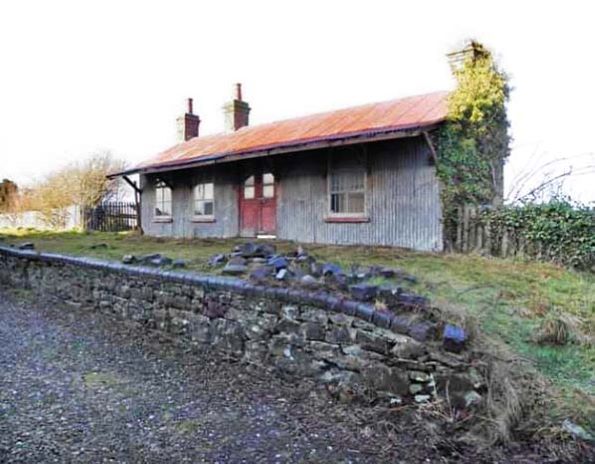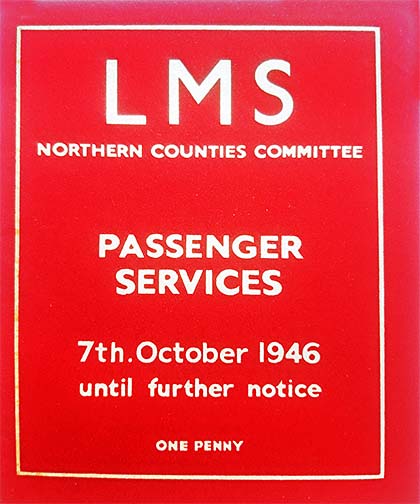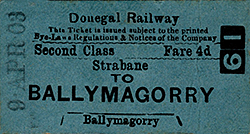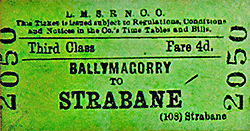 The Ballymagorry station building seen in 2009. The Ballymagorry station building seen in 2009.
Copyright photo by Pete Leigh from the Donegal Railway Heritage Centre collection
Ballymagorry is a small settlement in County Tyrone, Ireland 11¾ miles to the south of the city of Derry/Londonderry. On 7 August 1896 the Donegal Railway (DR) obtained an act to build a 14½ mile single track 3ft gauge railway between Strabane and the Waterside area that lay on the eastern bank of the Foyle opposite Derry/Londonderry. The course of the line passed to the east of Ballymagorry and a station was provided a short distance to the south-east of the settlement to which it was linked by Station Road. In 1896 the DR had a 74 mile network of 3ft gauge railways that had Strabane as their easternmost point. To get goods and passengers to and from the important city of Derry/Londonderry required the use of the Great Northern Railway Ireland (GNRI) 5ft 3inch gauge line between Strabane and Londonderry Foyle Road. Financially this situation was to the detriment of the DR and to the advantage of the GNRI, which was the primary reason for the line.
 The line opened for goods services on 1 August 1900 and passenger services began six days later. A station was at provided at Waterside which was called Londonderry Victoria Road. Passengers and goods could move into the city via the double deck Carlisle Bridge which was adjacent to the station. Ballymagorry station was 2¾ miles from Strabane and 11¾ miles from Londonderry Victoria Road. The line opened for goods services on 1 August 1900 and passenger services began six days later. A station was at provided at Waterside which was called Londonderry Victoria Road. Passengers and goods could move into the city via the double deck Carlisle Bridge which was adjacent to the station. Ballymagorry station was 2¾ miles from Strabane and 11¾ miles from Londonderry Victoria Road.
Being a single track line only one platform was provided at Ballymagorry. It was located on the north side of the line. The main passenger facilities were located in a simple single storey brick building with a booking office and waiting room and only Donemana on this branch had similar passenger facilities.
The station had goods facilities which consisted of two sidings and a small goods store and cattle pens, located on the south side of the line opposite the passenger station. The 1904 Handbook of Stations listed Ballymagorry as being able to handle general goods, parcels, furniture vans, livestock, horses and private carriages by train. With facilities for handling such a wide range of goods it was clear that the DR considered Ballymagorry to be an important station on the line.
At the time of opening Monday-to-Saturday there were 6 trains each way between Victoria Road and Strabane and the CDR hoped to develop some commuter traffic along the Finn Valley through to Derry/Londonderry. Trains left Victoria Road from 07.15 to 7.25pm and some of these trains continued to Stranorlar and even Killybegs. In the return direction trains left Strabane for Victoria Road at times from 08.30 to 7.25pm. At this time there were no Sunday services.
Victoria Road was not the only station at Waterside. Londonderry Waterside station had opened in 1852, and since 15 May 1860 it had been the terminus of the Belfast & Northern Counties Railway (BNCR). In 1903 the BNCR had been taken over by the Midland Railway (MR) an English company that had aspirations for expansion in Ireland. They looked west from Derry/Londonderry and saw an opportunity in the form of the DR. They entered into discussions with them with regards to a takeover. The GNRI saw this as a threat and made it clear that they would try to block such a move. A compromise was reached which involved the MR and the GNRI taking control of the DR as equal partners. On 1 May 1906 the DR was absorbed by the two larger companies who ran it through a board as the County Donegal Railway Joint Committee (CDR). As the GNRI had a route between Strabane and Derry/Londonderry the line through Ballymagorry (between Londonderry Victoria Road and Strabane) passed solely to the MR. Staff at Ballymagorry station became MR NCC employees and as the sole owner of the branch that company was responsible for all of the infrastructure. However as the line was actually an integral part of the CDR network all of the train services (passenger and goods) were operated by them.
 In the 1910 timetable there were still 6 departures from Victoria Road and 5 from Strabane with a special express service on Fair Days only from Letterkenny, though this was not booked to call at Ballymagorry. In 1912 a Sunday service of one train in each direction was introduced. In 1913 an additional Sunday out and return working was introduced. In the 1910 timetable there were still 6 departures from Victoria Road and 5 from Strabane with a special express service on Fair Days only from Letterkenny, though this was not booked to call at Ballymagorry. In 1912 a Sunday service of one train in each direction was introduced. In 1913 an additional Sunday out and return working was introduced.
On 4 August 1914 the British Empire declared war on Germany and entered the Great War. From 1 January 1917 the CDR was taken under government control (along with all of the other Irish railways). The Sunday services were withdrawn in 1917 and never reinstated. The weekday service was also reduced to four trains in each direction.
In 1919 the Irish War of Independence broke out and it caused much disruption to the CDR system. In December 1921 a treaty was negotiated which resulted in the island of Ireland being split into two separate countries, the Irish Free State and Northern Ireland which remained as part of the United Kingdom. The majority of the CDR lines were located within the Irish Free State but the route through Ballymagorry lay within Northern Ireland. This caused difficulties for the company, which were exacerbated by the outbreak of the Irish Civil War (1922-23) which caused even more disruption. The least disrupted route was the Londonderry Victoria Road – Strabane line on which no major incidents were recorded as it ran through a mainly Unionist area.
The July 1922 timetable showed Ballymagorry as having three up and four down passenger trains Monday-to-Saturday. The first departure was the 7.31am down train for Strabane. The other three down services departed at 10.51am, 3.00pm and 5.41pm. The up direction trains ran to Londonderry Victoria Road departing at 8.30am, 9.29am and 3.40pm. The journey time to Strabane was 9 minutes and to Victoria Road it was 45 minutes.
In 1923 the MR was absorbed into the London Midland & Scottish Railway (LMS) who became the part owner of the CDR and the owner of the Strabane – Londonderry Victoria Road line. The LMS let their network in Northern Ireland operate as the Northern Counties Committee (NCC).
In 1934 (following the closure of the engine shed at Londonderry Victoria Road) the passenger service was reduced to three trains in each direction and some of these were mixed trains.
 During the Second World War (1939-45) the CDR saw an upturn in traffic. There was a high volume of cattle movements in particular from the Irish Free State to Londonderry. Because the GNRI main line between Londonderry Foyle Road and Strabane passed through the Irish Free State it could not be used for the movement of war materials or troops (the Free State being a neutral country). As the Londonderry Victoria Road and Strabane line was located entirely within Northern Ireland serious consideration was given in 1942 to making it dual gauge (3ft and 5ft 3in), so that GNRI trains could reach Londonderry without having to pass through the Irish Free State. In the end the idea proved to be too complicated and all war related traffic had to operate via the LMS NCC main line to Derry/Londonderry, a vital wartime naval port, instead. During the Second World War (1939-45) the CDR saw an upturn in traffic. There was a high volume of cattle movements in particular from the Irish Free State to Londonderry. Because the GNRI main line between Londonderry Foyle Road and Strabane passed through the Irish Free State it could not be used for the movement of war materials or troops (the Free State being a neutral country). As the Londonderry Victoria Road and Strabane line was located entirely within Northern Ireland serious consideration was given in 1942 to making it dual gauge (3ft and 5ft 3in), so that GNRI trains could reach Londonderry without having to pass through the Irish Free State. In the end the idea proved to be too complicated and all war related traffic had to operate via the LMS NCC main line to Derry/Londonderry, a vital wartime naval port, instead.
Interestingly post war LMS working timetables referred to Ballymagorry as a halt but it was still staffed and still handling much goods traffic for the local agricultural community. The 1946 passenger timetable has the station listed as simply Ballymagorry. That timetable (see below) showed that three trains in each direction was still the norm. Passenger numbers were low by this time and most trains consisted of only two coaches.

In January 1948, when the LMS was nationalised as part of the Railway Executive the NCC share of the CDR passed to the London Midland Region of British Railways. By April 1949 the railways of Northern Ireland, with exception of the CDR, GNRI and the SL&NC (as they operated in two countries), were also nationalised as part of the Ulster Transport Authority (UTA). In April 1949 the former NCC network was purchased by the Northern Ireland government on behalf of the UTA for £2.67 million. Being part of the NCC network the Strabane – Londonderry Victoria Road line passed to the UTA but it continued to be worked by the CDR. The UTA paid the costs of the Londonderry Victoria Road service and that meant that there was no incentive to economise. For this reason the trains on this section of the CDR network were always steam operated and the CDR designed their timetable after the 1930s so that all steam locos in service would visit Victoria Road to get coaled.
 The UTA announced its intention to close the line between Londonderry Victoria Road and Strabane in October 1954. The last trains ran on 31 December 1954. The very last passenger departure from Ballymagorry was a down train that departed for Strabane at 7.45pm. The UTA announced its intention to close the line between Londonderry Victoria Road and Strabane in October 1954. The last trains ran on 31 December 1954. The very last passenger departure from Ballymagorry was a down train that departed for Strabane at 7.45pm.
On 29 June 1955 a light engine made a journey through Ballymagorry as part of a round trip between Strabane and Londonderry Victoria Road. The purpose of this movement was to test the permanent way for a special excursion train that was to run on 30 June 1955. The excursion train, carrying Sunday School children as part of an outing to Portrush (via a short walk between Victoria Road and Waterside stations), operated as scheduled. The down train that passed through Ballymagorry on the return leg of the journey would be the very last passenger train to pass through the station.
Track lifting began at Londonderry Victoria Road in November 1955 but Ballymagorry was not reached until the end of the year. Track lifting was undertaken using road vehicles.
The station building fell into the hands of the family of the last Stationmaster of Ballymagorry after closure in 1955. The station building was lived in until about 2000 and as a result of this it remained in good condition until 2009. Even the platform canopy was still in good condition at that time. In 2020 the station building was little changed from closure in 1955 but the canopy had collapsed and even though the station building was Grade 2 listed it was showing signs of neglect. The station platform and the goods shed still survived as part of a private residence built on the north side of the former station where a former rail overbridge had previously existed. |

 Home
Page
Home
Page

 Home
Page
Home
Page